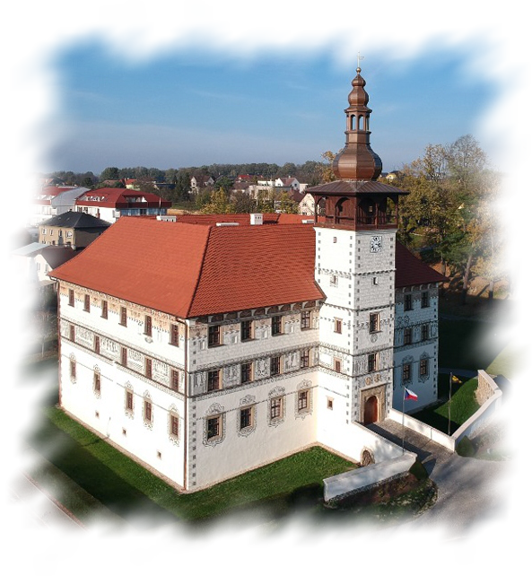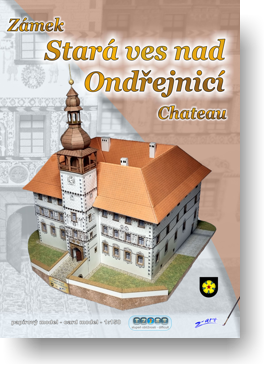

ABOUT STARÁ VES NAD ONDŘEJNICÍ CHATEAU
The village of Stará Ves nad Ondřejnicí is located in the northeast of the Czech Republic near Ostrava city and has approximately 2500 inhabitants. The first written mention of the village dates from 1267 – back then, it was called Bruneswerde after its owner, the bishop Bruno of Schauenburg. He mentioned this village in his will before his departure alongside King Přemysl Otakar II. to the crusade in Prussia. However, this place had been inhabited much earlier – it was a part of the urban hinterland of Brušperk. In the 14th century, the village was divided into two or three manors and was united again only at the beginning of the 16th century. At the time of the division, each manor had its own farmyard and it is likely that one of them gave rise to a fortress which laid the foundation for today´s castle.
The first written mention of the fortress comes from 1551, when it belonged to the Čepel of Belek family. It had a square floor plan, just like today. The fortress was surrounded by a moat, fed by water from the local ponds cascade. In its early times, the fortress was mainly wooden, with a defense wall surrounding the yard, with a residential building and farming buildings. The reconstruction from 1565-1575, when the fortress was owned by the Syrakovský family, resembles today´s appearance. The original wooden fortress burned down and its reconstruction was done in a lavish style, with a residential building decorated with arcades and sgraffitos, and with several outbuildings, including a brewery. Under the castle, a large water mill with a saw for cutting logs was built. There are still two coats of arms above the entrance façade of the castle, commemorating this period of construction. The left coat of arms represents the castle builder Jaroš Syrakovský and the right one is devoted to his wife Kateřina Petřvaldksá of Petřvald. The Syrakovský family, especially Jaroš´s son Ctibor, ruled justly and generously, taking care of the castle, local school, rectory and the entire village.
During the Thirty Year´s War, in 1643, the castle was conquered and occupied by the Swedes. However, they only left a small garrison here and this enabled the inhabitants of Stará Ves to recapture the castle with flails and pitchforks. The peace time only lasted until 1663 when the Turks invaded, looting and murdering everything in their path. Fortunately they were stopped in a nearby town and Stará Ves was not affected by these battles. The chateau was repaired again and experienced prosperity, but over the decades it gradually began to deteriorate and lose its importance. In the 19th century it was already mentioned as a “deserted manor house.” The castle turned into an economic and administrative building. In 1930´s, it was a Police station, there were apartments and there were vegetable gardens around the building. During one of the last battles of WW2, Germans made a machine gun nest in the tower. As a response, Russians shot the tower into pieces. In 1950´s, there was a school, nursery and health center here, and there was a rather unsuccessful attempt to repair the sgraffito. A high-quality general reconstruction took place around 2000 and then again in 2018-2019. Since 2005, the municipal office, library and restaurant have been located here.
ARCHITECTURE OF THE CHATEAU
The chateau was built in the Renaissance style, it is two-storey, with a dominant tower. It has a square floor plan and a square inner courtyard. At first glance, the visitor is amazed by the rich sgraffito decoration, especially its figural part, depicting biblical motifs, scenes from the Turkish wars, and antique motifs. There are also stripes and decorations around the windows with flat floral motifs, and flat and corner checkering. Another dominant feature is the 36-meters-high pass-through castle tower. After its top was destroyed during WW2, there was just a temporary roof for many years. However, in 2019, a replica of the original tower roof was installed here. It is 14 meters high, weighs 20 tons, and two tons of copper were used for its production. The inner courtyard is also worth mentioning. It is surrounded by arcades on all four sides, which is unique in Czech Renaissance castles. Renaissance arcades were built on all three floors. The columns on the ground floor are octagonal, while on both upper floors they are cylindrical. There are remnants of sgraffito on the walls, suggesting there was rich decoration even in the courtyard. The former moat is crossed by a stone bridge - but in the past, there was a wooden drawbridge. An observant visitor can spot a small gate in the stone wall – there used to be a hidden passageway, probably leading to a former carriage house, but now it is full of rubble and due to many building modifications in the past, we will never know its real purpose.
text Simona Čechalová
You can order in our e-shop.
Back









